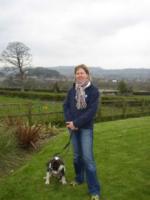
Work Package Livestock production, health, welfare and disease control
Introduction
The welfare of farmed livestock is a high-profile ethical issue of concern to citizens and consumers, policymakers, veterinarians, animal welfare pressure groups, levy bodies like Quality Meat Scotland and across the food supply chain from farmers to food processors and retailers. Animal welfare standards are affected by EU regulations, UK and Scottish Law, but also through voluntary schemes, such as farm assurance labelling schemes which aim to give consumers confidence in good animal welfare.
We use various methods to assess animal welfare, but animal behaviour is a key measure common to all our studies. We make use of commercial and research farms for our studies, and work closely with farmers and other industry stakeholders. Our aim is to perform high quality scientific research and to provide farmers with the practical information they need to improve welfare. Our work is informed by The Scottish Government’s Animal Health and Welfare Strategy, which emphasises the need to develop and use animal-based measures of welfare, rather than assuming all is well if a system complies with the law.
Aim of Research
Our aim is to provide an evidence base for advice to farmers on the best approaches to improve the welfare of their animals. Guided by Scottish Government (RESAS) priorities, our work covers two specific areas, covering 4 species of commercial importance:
- The management of feeding in pregnant breeding animals (sows and beef cattle) to optimise the health, welfare and production of the mother and her offspring.
- Reducing pain in two species: In laying hens – investigating housing methods to improve welfare by reducing the need for beak trimming; and in lambs reducing the need for, and identifying less painful methods of, castration and tail docking.
Progress
Pregnant animal diets: Work on gastric ulcers in sows included a study of ulcers of sows culled (for management reasons) from our research herd. Observations of oral behaviours and saliva samples for metabolomic analysis were taken and ulcers were characterised and scored. Analysis will determine whether behaviour or saliva markers could be used to diagnose ulcers in living sows, which is currently very difficult.
In beef cattle our long-term farm study found benefits to cow and calf of optimal condition during pregnancy, prompting farmer KE around body condition scoring, including a new farmer leaflet. We conducted economic cost-benefit analysis around the measures farmers could take to optimise cow condition during pregnancy (scenarios included concentrate, silage, or no additional feeding). We made use of considerable involvement and feedback from SRUC beef consultants. The modelled interventions returned a net economic benefit compared to allowing condition loss, indicating that better condition management ought to be of direct economic benefit on most farms. A draft policy brief has been prepared for circulation to Scottish Government outlining these results.
Painful procedures: To reduce the need for painful beak trimming, improvements to the environment to reduce feather pecking were explored- using enrichments and various scratch mat designs. Our enrichment study used eight commercial free range flocks. All hens had jute ropes, and were either given more ropes, or lucerne hay bales, pecking blocks or pelleted feed. Although all enrichments were used more by hens than ropes, there was no improvement to feather cover. Findings have been published in a peer-reviewed journal, in a poultry magazine, and at a UK poultry conference
Our study into different scratch mat designs used in commercial colony cages found that birds used them to a similar extent, and that this had little effect on feather pecking. We produced a report and this was reported on an industry website. We also reported on earlier work on the welfare of multi-tier vs single tier housing at an international poultry conference, and at the pig and poultry fair, as reported in Farmers’ weekly.
Other areas: The extension of the programme to a sixth year due to COVID-19 allowed new areas of work to be addressed. We produced a policy brief on the potential to make better use of food waste for livestock feed. There are opportunities to make better use of food waste (much of which goes to incineration or landfill), promoting a circular economy, although law changes would be needed. With a number of developments in the UK and internationally in free farrowing systems and the rules encouraging their use, we reviewed literature and analysed data comparing systems for the reproductive success of sows (piglet survival, fertility, litter size) and long-term impact on piglets (growth rate). We held an International Free Farrowing and Lactation 2021 virtual workshop, and produced a policy spotlight about our findings.
Activity monitors are being used on dairy farms, in particular for oestrous detection, and here we looked at their potential to detect behavioural changes that indicate disease onset. Our earlier work had shown that changes to lying and feeding patterns could warn of respiratory disease in calves. Here we focussed on play- first we characterised the activity monitor signature of normal calf play, and then analysed how it was altered with respiratory disease and scour. Although we found age-based changes, a disease signature was not evident.
We also produced two training sites: one on learning about the Guidance for the Welfare of Laying Hens and Pullets, and one for Lion Code Passport accreditation.
Pregnant animal diets:
A study of oral behaviours in finishing pigs and sows showed that self-directed oral behaviours (like sham chewing, snout twitching and tongue playing), which have previously been associated with hunger in restricted-fed dry sows are seen in some ad-lib fed finishing pigs. This means hunger can’t explain them, and other causes such as gastric ulcers should be further investigated. Our large longitudinal study of 3000 pregnant beef suckler cows showed that large variation exists within and between Scottish beef farms in body condition and how it changes over pregnancy. Improved management of body condition could reduce feed use and associated costs and improve calf vigour, size and long-term growth rate. As well as ongoing farmer knowledge exchange on the importance of body condition scoring and management, we produced a research brief published through SRUC’s Rural Policy Centre and a SEFARI research update.
Painful practices:
We published a paper validating the use of Qualitative Behavioural Assessment to assess acute pain in castrated lambs. A Defra funding bid to explore low-pain castration methods including Easyclamp and methods which deliver local anaesthesia, and an invited plenary talk on the welfare of extensive animals were delayed due to Covid-19.
As regards beak-trimming and feather pecking, a peer-reviewed article paper on the effect of scratch mats on hen behaviour in enriched cages was published. Hens mostly stood or sat, occasionally using the mats for foraging, preening or walking but never dust-bathing. Adding feed to the mats didn’t affect their attractiveness to birds, and all designs were similar.
~~Management of feeding: A new PhD student started work in this area and has begun two studies: one to understand the causes and development of oral behaviours in growing pigs, gilts and dry sows; and another to study of cull sow stomachs to assess the prevalence of gastric ulcers. Our large longitudinal study of 3000 beef cows on diverse commercial farms has identified how management of cow condition during pregnancy (autumn to spring) varies, and how this influences calf vigour. Knowledge exchange at agricultural shows and other events has been popular with farmers, as we use our model cow backs to discuss pregnancy condition scoring best practice.
Reducing pain: A clamp which reduces lamb castration pain has been refined, and a paper on the impact of using this device has been submitted for publication. This was a proof of concept study and we have approached Defra to fund a new study into its use. A paper on the use of Qualitative Behavioural Assessment in assessing acute pain in castrated lambs has been submitted for publication. An end to beak trimming of laying hens requires alternative ways to reduce feather pecking: two new studies using various enrichments and scratch mats were started at 9 commercial farms. This work is ongoing, although some visits were curtailed by avian influenza. A new PhD student began working on investigating if naturally-occurring beak variation is readily-identifiable in the population, and if it is heritable, in order to select hens with naturally duller beaks to help reduce the damage caused by feather pecking. Her first two studies with a commercial breeding partner are underway.
Management of beef cow body condition: Data are now being analysed to understand the effects on calf welfare, health and productivity of their mother being over or under-weight during pregnancy. Only a minority of farmers routinely condition score their cows and many lack confidence in scoring. In 2018-19 we secured additional funding to build life-size models of cows at different body condition scores to train farmers. This year we have trained farmers at 7 major agricultural shows across Scotland and Northern England and at a further four Scottish beef industry technical meetings. One-to-one training has been provided to approximately 650 farmers plus vets and other industry specialists. The models have also been used as a student training tool to support long-term improvement of this skill in the industry and at three industry and publicly attended conferences.
Work on sow diets, engaging with the feed industry, identified an interest in the problem of gastric ulcers in sows, which we have previously investigated in growing pigs. Our studies have also identified that oral behaviours occur both in young sows (gilts) before feed restriction begins and in older sows fed to appetite for 3 days. These oral behaviours are often thought to result from feed restriction, and these findings suggest that they may have an additional cause. PhD funding has been obtained to further investigate sow diets and gastric ulcers. In laying hens, various industry knowledge exchange activities have publicised our report on single- vs multi-tier study systems, and a further study on scratch mats in furnished cages has been planned. In lambs, several novel methods of castration have been assessed, and a new clamp device showed promising results. Data have been written up for the scientific journal Animal Welfare. In beef cattle, we are making good progress in our major longitudinal study, to investigate effects of how thin or fat the cow is during pregnancy or how changes in her fatness as pregnancy progresses affects calf performance and health and welfare. We have also won additional funding to 1) Examine the effects of cow body condition during pregnancy on early lactation energy balance and (2) To construct models of cows at different condition scores to train farmers.
Research has led to published papers, reports, magazine articles and newsletters as well as direct engagement with stakeholders. Lamb pain: we engaged with industry on new castration methods, and have begun a study to test one. Rubber ring tail docking of lambs- first time mothers showed a stronger reaction to signs of distress from pain in their lambs than older ewes. Laying hen systems: a study on 42 commercial farms found that multi-tier housed hens are more profitable (farmer gets £0.63 more per bird) but were more at risk of keel bone damage than single-tier housed hens. A report for the industry was published with the British Free Range Egg Producers
Association (BFREPA). Diets for feed-restricted pregnant sows: Providing sows with straw bedding caused some oral behaviours (bar biting, and nosing both the floor and other sows) to be reduced but most were unaffected. Sows fed as their appetites demanded ate double their usual ration, suggesting they are hungry. An article for a farmer’s newsletter was produced highlighting this problem and discussing dietary fibre as a solution, while another article highlighted our recent industry survey showing the diversity of dry sow systems, management and diets in the UK. Feeding Beef suckler cows: we found that maternal condition at mating and in late pregnancy affected both calf weight and calving ease. Body condition scoring of cows on 38 Scottish herds revealed over 30% were too fat, and a concerning number were too thin. We spoke at 4 farmer meetings on the importance of correct feeding during pregnancy.
We produced information for farmers on whether tail docking and castration are needed in lambs, and best practice for minimising pain. Farm visits have begun to compare the health, welfare and performance of laying hens in single or multi-tier barns and free range systems. Our research in beef cows shows that condition score (fatness) should be measured at the beginning and end of pregnancy to ensure ideal calf weights. This work is the beginning of a major longitudinal study to look at the practical implications for cattle of the fascinating science of developmental programming about which we published a major review. A review of pregnant sow diets identified a mis-match between research and industry practice- sows remain unsatisfied and hungry, and would benefit from more soluble fibres.
Future Activities
Knowledge exchange activities on our major results will continue into the 6th year of the programme. In particular, our ‘hands on’ models of cow backs used at agricultural shows and other events to educate and start discussions with beef producers around condition scoring have been a real hit with farmers. Production of video and other promotional materials, and scientific papers around this topic are planned; and the issues around beef cattle and calf management will continue into the next programme.
Management of feeding: Work on sow diets will focus on the development of oral behaviours, understanding their relationship with gastric ulcers in cull sows. If we successfully identify specific oral behaviours associated with ulcers, this could be used as an on-farm diagnostic tool.
Reducing the need for painful procedures: To reduce the need for beak-trimming in laying hens, we will work with free-range hens at commercial farms, investigating the use of various enrichments to prevent feather pecking. Data collection has been somewhat delayed due to Covid – 19 but will resume in year 6, along with reporting and knowledge exchange activities. Further data collection on the heritability and selection of dull beaks, and innovations to reduce pain for castrated lambs continue in the next RESAS programme.
New areas are being developed for the next RESAS programme, including the animal welfare implications of EU exit, using human behaviour change methods to improve uptake of animal welfare best practice and innovation; the potential precision livestock farming technology for monitoring animal welfare, the importance of enrichment for positive welfare. We will also focus on practical alternatives to farrowing crates for sows and ethical management of dairy calves.
Selected Outputs
Lamb castration what are the options
Epigenetics and developmental programming of welfare and production traits in farm animals
Can non-beak treated hens be kept in commercial furnished cages? Exploring the effects of strain and extra environmental enrichment on behaviour, feather cover and mortality
The welfare and economic benefits of multi-tier and flat deck free range systems
Mitigating hunger in pregnant sows
Article on fibre in dry sow diets
Article on gastric ulcers in pigs
Article reporting on a survey of dry sow housing and management
Major weight loss in pregnant cows harms the development of their calves
Ewes direct most maternal attention towards lambs that show the greatest pain-related behavioural responses
Lamb castration what are the options
Epigenetics and developmental programming of welfare and production traits in farm animals
Can non-beak treated hens be kept in commercial furnished cages? Exploring the effects of strain and extra environmental enrichment on behaviour, feather cover and mortality
The welfare and economic benefits of multi-tier and flat deck free range systems
Mitigating hunger in pregnant sows
Article on fibre in dry sow diets
Article on gastric ulcers in pigs
Article reporting on a survey of dry sow housing and management
PigWorld: Free farrowing systems - the importance of genetic selection
PigProgress: Free Farrowing is not a matter of “when” but “how”




